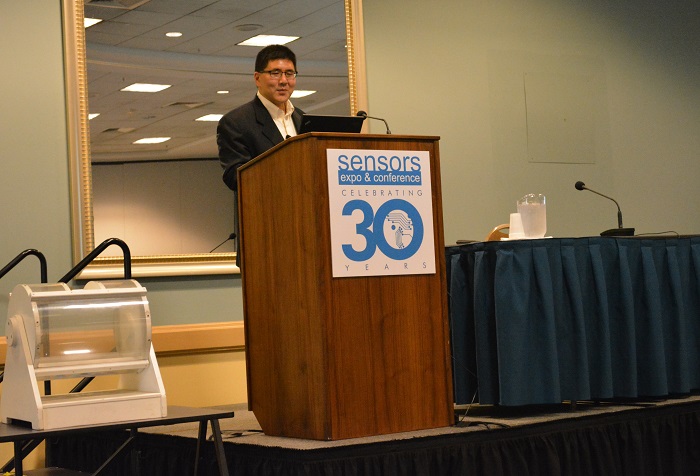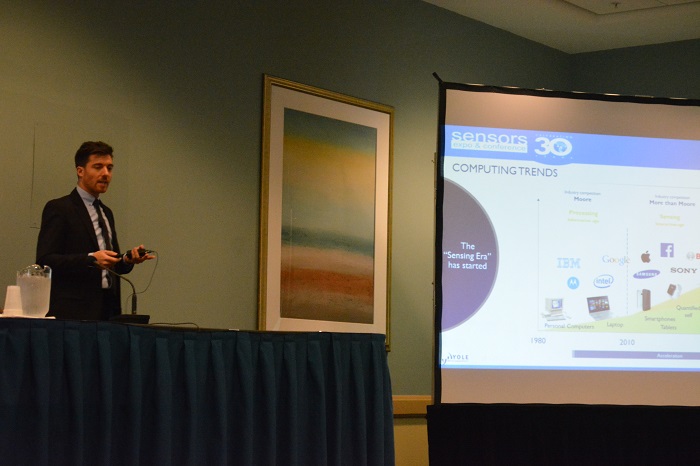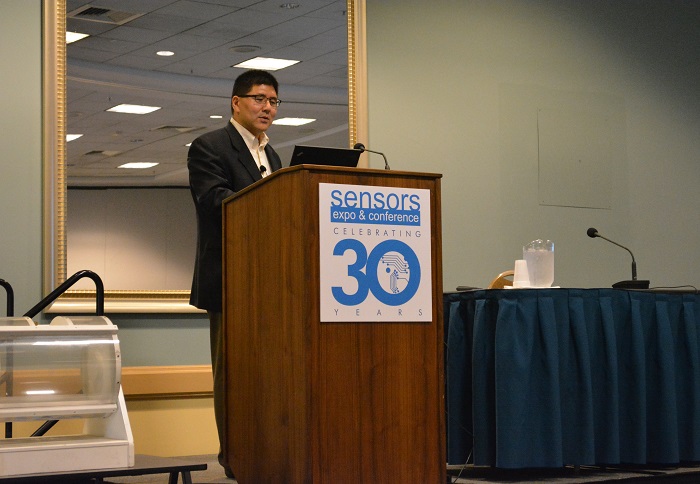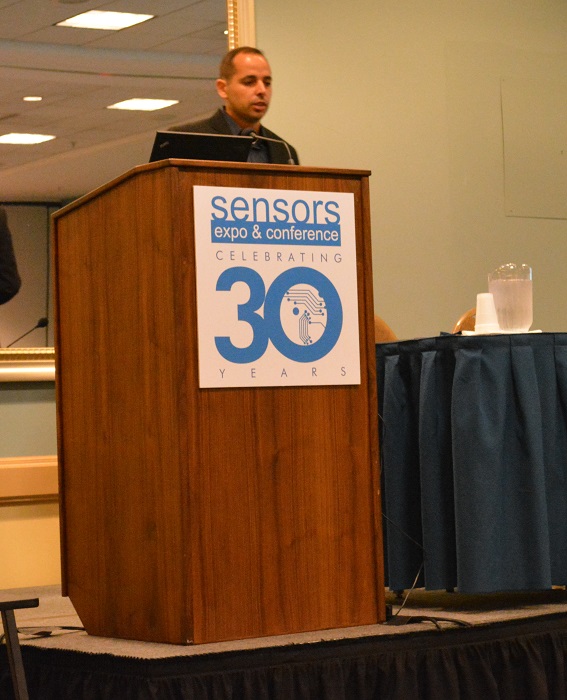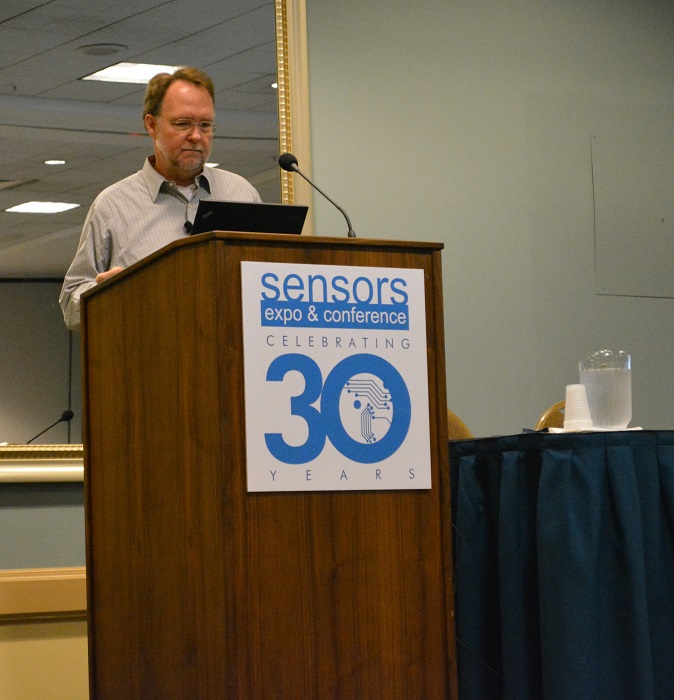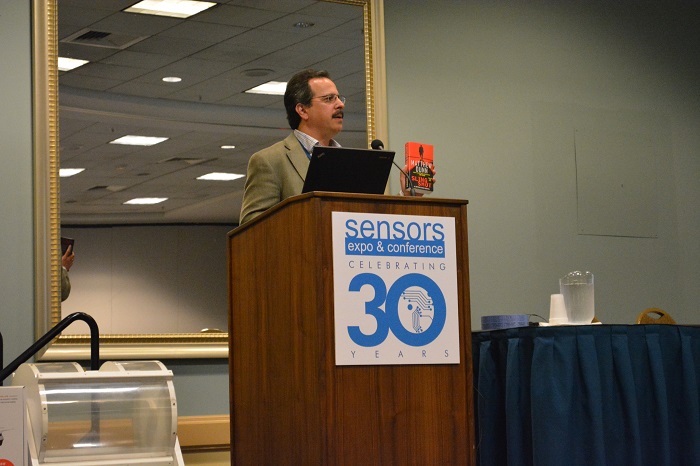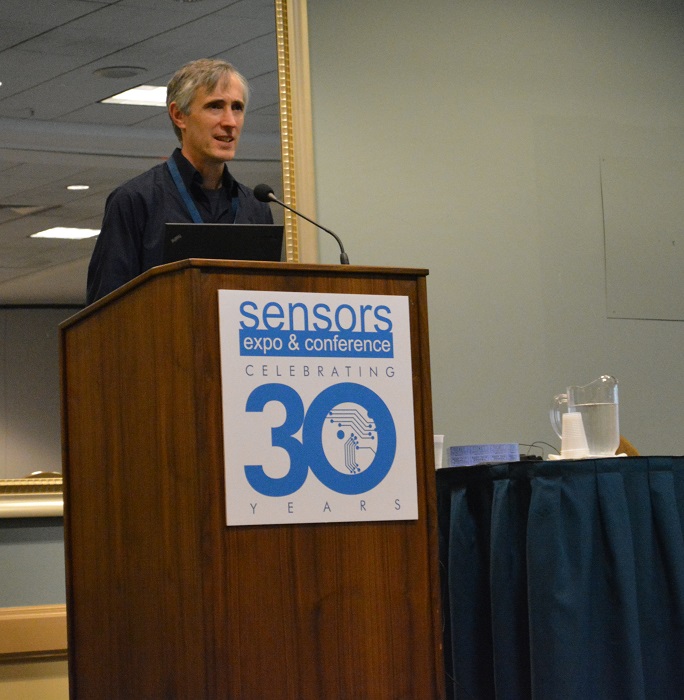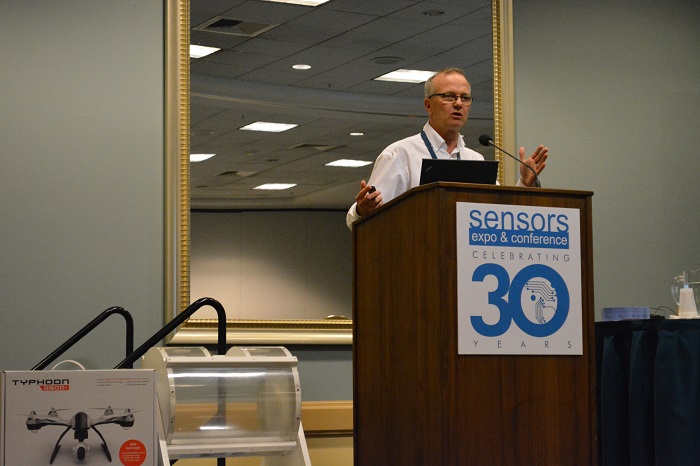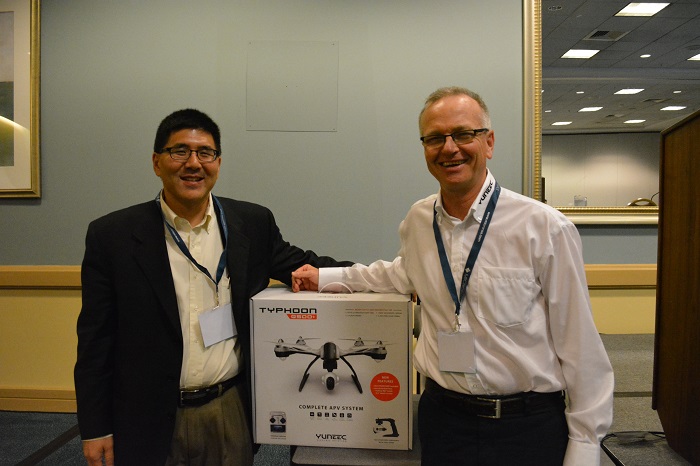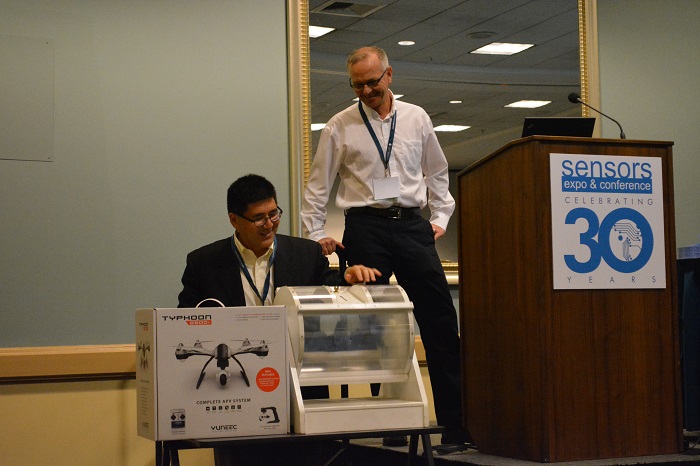by Dot Cannon
Your future voice-activated car could contain at least three microphones. Sometime soon, when you can’t travel back to a favorite spot, you’ll be able to use a drone for a “virtual tour”.
Oh–and at some point, you may have an electronic nose in your refrigerator.
These were just some of the ideas discussed on Tuesday, during one of Sensors Expo and Conference‘s three pre-conference symposia.
The day-long events at the Long Beach Convention Center marked the thirty-year anniversary of Sensors Expo and Conference, the only event completely dedicated to sensors and sensing technologies. In 2014, engineers from 45 states and 40 countries attended the conference, according to the Sensors Expo and Conference website.
On Tuesday, the subject was innovation.
Will Tu, Director of Embedded Solutions at ARM, in Detroit, moderated the day-long symposium entitled “IoT: The Final Frontier for Embedded.”
And the focus was on getting different technological elements to work together–in ways similar to our own five senses.
“Not only are we going to talk about hearing and seeing, we’ll talk about smell,” Will said,in his introduction.
(Now, the Internet of Things, or “IoT”, is the concept of connecting everyday things to the Internet–and having them “talk” to other devices.)
The first speaker, Market and Technology Analyst Guillaume Girardin from Yole Developpement in Villeurbanne, France, predicted an exciting future in his presentation, “Market View for IoT”.
“We think the real Internet of Things era will start after 2020,” he said. One of the slides in his presentation spanned the next thirty years with a projection of “smart homes” by 2030, with robotic servants, autonomous vehicles and even telekinesis projected for the following decade.
“Voice user interface could be the next killer app in the future,” Will said, taking the podium for a presentation on “Microphones: Hearing the Future of the IoT”. Some of the ways he envisioned that app working included a microphone in every light bulb, as well as “smart TV” that interprets a viewer’s mood through voice tone and offers programming accordingly. Cooking was a third:
“I’ve got a piece of chicken. The system can say, ‘how big is it?’ ‘It’s the size of a fist.’ Then, the microwave knows how long to cook it…it doesn’t take a lot of computing power to do embedded voice commands.”
Will said that the sensors of today are all about trying to mimic human senses “I would probably say the microphone is the sensor with the most potential to kind of unlock IoT.”
But, he added, there was a “catch”–a scarcity of resources in the microphone space. He said that, according to a LinkedIn search, there were only eleven audio professionals with the skills to create audio processing software. “That’s one of the reasons you don’t see a proliferation of microphones in embedded projects yet.”
Daniel Brauch, Atmel Senior Manager of Wireless Product Marketing, gave a presentation on “Future of Connectivity, From Tiny Sensors to Cloud.” He said diverse technologies presented one of the challenges of connecting everything on the Internet of Things.
“Smart city gateways and smart metering need more horsepower than smaller applications,” he said. “All of these references share one thing in common: it’s an ocean of software.”
Currently, Daniel said, ZigBee, Wi-Fi and Bluetooth cannot talk to each other–but changes are coming. “We are also adding today a communication agent,” he explained. “What we’re doing today is trying to make this communication agent agnostic to the technology with which it’s working.”
Security, he said, was a key ingredient. “What we see today, it’s not enough. We’re trying to put (safeguards) on all the layers (of technology). You don’t want your smart city hacked by your toaster.”
In his presentation, Bill Curtis, Senior Director of Strategy at ARM, said the Internet of Things needed to grow in a different direction. “We don’t have the Internet of Things, we have silos of things,” he said. “We have devices and applications paired. That’s not what we want. We want services and applications to be pairable at any point in the value chain.”
Bill said the goals for the future included having anyone be able to write applications and create devices for the Internet of Things. “We have a program called ARM mbed®,” he said. “It’s an open source community with an online set of development tools so you can get started right away.”
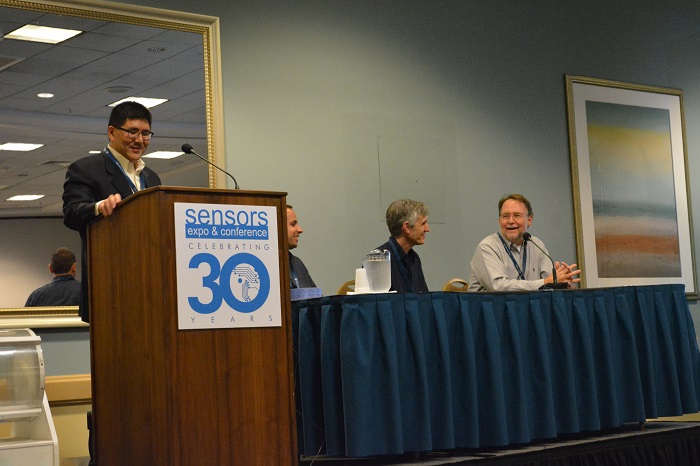 Later on in the symposium, a panel discussion addressed the topic: “Do Sensors Need to be Smart?”
Later on in the symposium, a panel discussion addressed the topic: “Do Sensors Need to be Smart?”
“I’m looking forward to the day when IoT devices behave just like my wifi,” commented Bill Curtis.
Embedded vision was the next topic, as Jeff Bier, Founder of the Embedded Vision Alliance, took the podium. He said embedded vision was the second most important technology (after connectivity) for the Internet of Things.
“It is becoming very practical to put embedded vision into just about anything,” he said.
To illustrate, he held up a normally low-tech item. “I used Amazon Flow to buy this paperback in the airport,” he said, explaining that he’d pulled out his phone and scanned the bookshelves until he found a good mystery novel!
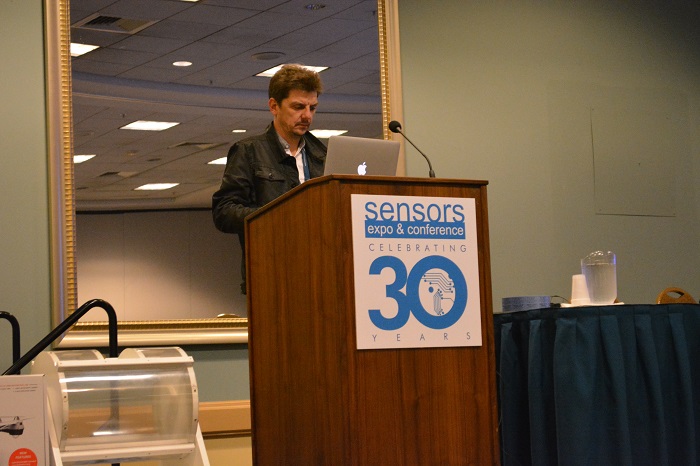 But one of the most surprising concepts of the afternoon came from Dr. Tristan Rousselle, Co-Founder and CEO of Aryballe Technologies in Lyon, France. He talked about–the future of electronic noses!
But one of the most surprising concepts of the afternoon came from Dr. Tristan Rousselle, Co-Founder and CEO of Aryballe Technologies in Lyon, France. He talked about–the future of electronic noses!
His company has developed the technology, called the eNose, for a number of uses: a portable device to patent perfume scents, which couldn’t be done before; a dedicated refrigerator device to detect spoiling food; and even to help patients with a rare disease called anosmia, where the sufferer has no sense of smell. Aryballe Technologies released the first version of the “eNose” in June of this year.”
Stephen Scheirey, Vice-President of Software Development at Hillcrest Labs, named seven considerations involved in developing the Internet of Things, during his presentation. These included whether an interface connected to people or machines.
Context, though, was a topic he emphasized.
“Augmented reality…requires tracking to the real world,” he said, using the example of looking at the constellations. “Virtual reality requires smooth tracking, to avoid motion sickness.”
Now–what symposium on future technology would be complete without a discussion of drones? Shan Phillips, COO of Yuneec Aviation Technology, said in his late-afternoon presentation that his company had just launched his first product at 2015 International CES in January.
“We’re still very much in the early days,” he said. “The majority of drones are actually being used by consumers, not yet (by)commercial entities. The ones we’re seeing the most? Wedding photographers, and really high-end realtors, as well.”
Shan also alluded to an exciting future use of drones: virtual tourism.
“Imagine if my wife and I could sit in our living room and rent a drone to virtually fly around Malapascua (where we honeymooned) and see it again,” he said.
However, Shan didn’t simply discuss drones. He had donated this one–and one lucky attendee won it in a drawing!
That was just the beginning for the Sensors Expo and Conference, which concludes in Long Beach today. (Gadi Amit, Founder and Principal Designer of NewDeal Design, gives a keynote speech on “Why the Sensor Explosion Needs Technology Design” at nine today in Long Beach Convention Center.)


